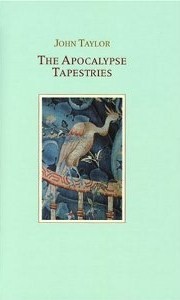Issue 4 - Winter 2011 Reviews Arranging the Blaze Beasts and Violins Crazy Jane Eating Fruit Out of Season Five Kingdoms Hard Rain Heathen Little Oceans Multiverse Open Slowly Psyche's Weathers Silent Music Something Must Happen The Apocalypse Tapestries The Darkened Temple The Kingdom of Possibilities The Tyranny of Milk This Pagan Heaven Woman on a Shaky Bridge You Know Who You Are Interviews
 |
The dramatic poetry and prose offered in John Taylor’s recent collection is composed of recurring themes that weave through the poems like threads in the same tapestry that provides this dramatic series with both stage sets and overarching proscenium. The Apocalypse Tapestry itself, situated in the Château d’Angers, is 103 meters long and comprises 67 surviving scenes of the Apocalypse that supposedly precedes the Day of Judgment. Obviously, one major theme of the book is religion; by turns, desired, cherished and repudiated by the author. It is evident that John Taylor, the poet, identifies with John the Apostle who is shown, as commanded by the angels, standing in many panels taking copious notes and recording events. The poet even asks for a blue coat like John’s.
Many of the pieces allude to the author’s despair as foreshadowed in the prefatory quote from Bonnefoy: “See, all the paths you went along are closed now…”. In “Chosen” he wonders if his humility caused him to be singled out or if his feeling of being chosen suggest the sin of pride. This sort of tension is not just theological speculation but a source of real anguish for Mr. Taylor. Part of the evidence of his special status stems from surviving dangerous feats as a boy and also from deliberately placing himself in peril in the worst slums of several cities. The maturing author searches for secular answers, and finds no transcendence in science and only despair in mathematics. But in “Secretum” he sees splendor in the present moment, a feeling reinforced by the last line of “Matter”: “You were alive./ C’est tout.” In “John’s Nightmare”, the author questions a bronze, godlike statue who shows him a heptagon of stars spinning in mid air and directs him to a table laden with the “… dizzying crisscrossing of a palimpsest--obscure oracles running through accounting legers, calendars, battle reports…” In order to interpret them, John would have to give up his own writings. He wonders: “Would I sacrifice my own words in a search for His?” In the end, of course, the author has chosen his own work, and in “Notes on Composition”, he relates how he writes, figuratively with two hands, one always selecting the true line “the just and genuine one…”. In choosing the best hand, he must frequently change, delete, pare back and sometimes start all over again to remain on the right path. In “Seeking Song”, the poet envies heroes who change the world through direct action, like the blackbird, the knight or “the angel with blood-stained wings”. He can only lead Pegasus through “the calm water of words”, his given métier, “ever tempted to grip the dangling reins”. In “Thereness”, the poet seeks to test the idea of ‘presence’, which has been pursued by generations of French poets and phenomenologists, by leaning out over the sill of a high window. But he’s stymied by an inner voice that warns, “Not too far”. He admires the white egret, the “sudden strawberries” and “the fragile poppy waving from the ditch”, and asks, “Who needs further signs, confirmations?” But the same fear as before prevents him from wading across a glacial pool in “Depths and Surfaces” as he ponders the deep drop-off in the middle. In “Betweenness”, he sees himself between earth and epiphany, always half way. If he manages to achieve momentary wholeness, he is immediately halved, and halved again, eventually being left a splinter. He cries: “Oh Lord, let me divide myself no further. I am now but a splinter of the beam.” He dares not assume “Victory” in the poem so titled as the hope of it has “…nearly destroyed me”. Many of the pieces are written a propos of places Mr. Taylor visits: Étretat, Champtocé, Varades, Ancenis, Oudon. In each of these sites, the pilgrim finds signs that signal the direction and meaning of his life. The book includes many prose pieces set in italics but also enclosed in quotes. These seem to be verbatim reports from all sorts of people: waiters, artists, prostitutes, deserted mothers, fishermen, soldiers, innkeepers and so on. They are often dramatic, capturing the phrasing and idiom of the speaker with uncanny accuracy. But the entrees are also politically relevant often identifying societal problems. While all the italicized passages represent other people, some without quotes may contain, according to the author, an infusion of “autobiographical fervor” or an attempt “to create doubt about the number of “Johns” possibly narrating”. Of the former, there is “The Son of the Scholar of Keats”, a young runaway whose professor father is characterized by his favorite phrase, “As it were”. In “Fleeing” a wife deserted with two female children struggles for years to support them, living hand-to-mouth and finally deserts them in turn, eventually opening a restaurant (which fails) with a bloke named Nigel. After hitchhiking around Europe, she ends up in Samos where she ends the story: “As to my girls… I have entrusted them to God.” “The Waiter” describes the footsore, fatiguing day of a server in a café who spends his days catering to tourists “desperate for alcohol and sex” and goes home to read Greek poetry. Similarly, “Spooky’s Life” is the story of another deserted woman who winds up as a prostitute in a gentlemen’s bar. Besides doing it in English and Dutch, she …”can wank a man off in Spanish, Italian, German”. She remarks, “On a given week, I would end up doing about everything two human bodies can do to each other sexually”. In retirement, she also finds a home in Samos. On a more exalted level, “You Have To Approach” is a moving evocation of an artist’s spiritual preparation before applying his paintbrush. Of the latter type of prose piece, where the poet speaks candidly in his own voice, there’s “C’s Discouragement” which describes the author’s deceased friend identified only by the letter ‘C’. In memory, the friend’s black mood, mirrored in espressos, is incited by the hopelessness that has dried up his creative powers. “Between us fell a silence that I can still feel (this morning…)”. “The Mirror” describes an eventful stroll through the Eros-Markt in Hamburg. “Into John’s World” shows a young boy (John himself or an avatar) raptly working on a drawing to create, Daedalus-like,“a maze from which he, the artist, might not be able to escape.” The concept of ascension, pointing to the synonymy of mountain climbing and faith, forms another leitmotif of this collection. “Ascending” poses the climber-pilgrim’s problem when he reaches that point in the trail where he must either attempt extremely dangerous slopes represented by pieces of loose shale, or turn back to safety. He decides go on for the reward of seeing Lac Clair with its promise of “clarity, luminosity”. He attains it but, after the erosion of time, forgets the memory of its clarity and thinks of it, ironically, as Lac Noir. In “The Useless Signpost” he comes across an uprooted signpost and realizes:
In “Iter Inceptum” (the journey begins) the poet again sees himself on an ascending road, this time outpaced by others who chide him for taking the “scenic route”. As a “wanderer” he has a better view, and greater perspective, but still doubts himself: “And what good to others, even to yourself/ is a view?” But he perseveres knowing that “You have to choose/ the once chosen path again/ and again”. “The Citadel” recollects the speaker’s high palace of refuge attained by vanquishing the powers of Babylon. But this memory only appears centuries later when Babylon, the citadel and all their treasures have crumbled to dust. Always the self-negating victory. The eagle, symbolic of sacred power, sometimes fills the sky in “Eagles of Fortune and Misfortune”, but sometimes there is only “an empty, eagle-flown sky”. The author pleads along with men in Hell to be devoured by God, as the marmot by the eagle’s babies, rather than burn forever”. But the pendulum swings back in “This Dust”, set in the Nevada desert; the writer notes how dust, in the biblical sense of primordial material, can bring forth life in the form of “tufts of blue sage… and tumbleweed”. In “Taming the Beast of the Sea”, Mr. Taylor once again identifies Satan with the Beast of the Apocalypse depicted in the tapestry. At first, the thought that the ‘beast’ is woven of lamb’s wool prompts laughter, but the demonic archetype cannot be laughed away. It still terrifies; yet the pen can slow its approach and (for the moment) walking away dispels fear. But the terror revisits in “Flames and Fingertips”; a meditation on death, cremation and, by extension, the flames of hell. In “Galah” a sun-worshipping nudist imagines herself impregnated by the sun’s rays. In “The Adoration of the Beast”, hedonists follow their sensual pursuits, but are struck (as Amfortas) with incurable sicknesses. As medicines fail and they pray for a divine cure; still, they continue to sin and cavort as “The stars above us swirled like poor Van Gogh’s cornflowers”. These poems, in their deeply felt, yet despairingly questioned, sense of faith, take their place with the likes of Vaughan, Herbert, Hopkins and Eliot in the canon of searing and inspiring religious poetry. John Taylor’s mastery of words and power of imagination surmount any qualms over religious orientation, or for that matter, mere atheism. Of course, there’s much more to report about this incredibly rich collection, but space prevents. Suffice it to say that the poems are “there”--not in splinters--but in wholeness, completion and clarity. The pilgrim has achieved apotheosis. Reviewed by Martin Abramson. |
